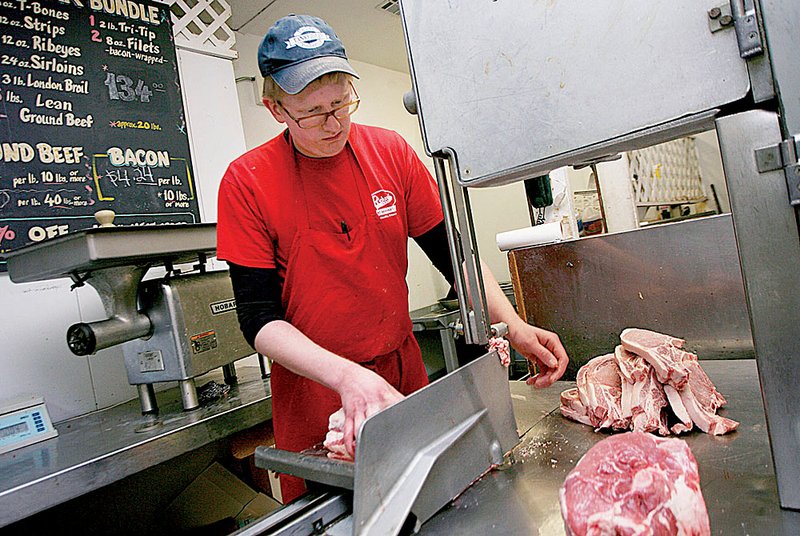LITTLE ROCK — During a weak economy the customer count at Richard’s Country Meat Market in Fayetteville is up, and total sales down.
“Customers are buying [less expensive] hamburger, not steak,” owner Richard McGinnis said, “and that makes a difference.”
But sales for the Christmas season were encouraging, and annual beef sales are returning to where sales need to be, the butcher said.
Beef consumption in the U.S. is down, and prices for shoppers are at historic highs. Industry experts said beef prices won’t stop rising until consumers reach a breaking point on price or a booming export market takes a downward turn.
Demand will slip if higher prices are not sustainable, said Travis Justice, executive director of the Arkansas Beef Council, which administers the state Beef Checkoff program. Beef producers pay for the checkoff program, a marketing and research policy aimed at increasing demand for beef. The average U.S. retail beef price of $4.57 a pound in December was an 11 percent increase in the year-over-year comparison, according to U.S. Department of Agriculture data released Thursday, a new record.
The average price was $4.02 per pound in 2010, according to government data.
Duane Lenz, the operating manager of Cattle Fax, a Centennial, Colo.-based trade group that owns the largest private database of industry-related statistics, said the higher prices are here to stay.
“And we’ll continue to see incremental increases in price until you can’t do it anymore,” he said.
Retail prices still have not kept the pace with rising prices for cattle and wholesale prices, said Lenz.
Cattle prices set a new record in the fourth quarter of 2011 at an average price of $1.27 per pound, he said.
“And at $1.23 per pound and $1.24 per pound, we’re starting to bump up against those levels” again, Lenz said.
With tighter cattle supplies, the leverage is with the ranchers and feedlots at this point, he added.
Packers have been unable to pass the higher costs along to retailers to keep margins in the black, government data from November show.
One reason beef sales are slowing is that packers are being forced to pass those costs to consumers in order to improve their margins, said Dan Vaught, a professional futures market consultant and founder of Vaught Futures Insight in Altus.
For consumers, the USDA’s national beef and veal Consumer Price Index data for 2012 shows another 4 to 5 percent price increase because of higher costs of cattle feed and reduced herd size.
The Consumer Price Index measures the average change over time in the food prices paid by consumers.
Richard Volpe a USDA research economist specializing in the food retail sector, said Thursday that the combination of high food prices and the weak economy has consumers moving toward lower priced meat options.
Consumer Price Index data for beef prices in November — the most recent USDA data available — were 9.8 percent higher compared with November 2010. Prices for both steak and ground beef steak were up 9.4 and 10.2 percent, respectively, USDA’s index data show.
“The [price] driver is a holdover effect from 2007 and 2008 when input cost increases from fuel and feed prompted ranchers, both beef and pork, to reduce inventories,” Volpe said.
By 2011 animal inventories were low, but there was strong demand from abroad, and “low supply and high demand is a recipe for high prices,” he said.
The total meat supply is forecast to be down 3 percent in 2012, experts say. And demand for beef in 2012 will be flat, according to Cattle Fax data.
The rising cost of beef comes at a time when the U.S. economy remains weak. Unemployment rates are high and the value of the country’s currency and interest rates are low. It’s also coinciding with droughts and high temperatures that have decreased the cow herds in states such as Arkansas, Texas and Oklahoma.
The USDA reports U.S. beef exports will grow 21 percent in 2011, when annual numbers are tallied, and exports to Asian markets such as South Korea have driven demand.
John Navilka, a consultant with Sterling Marketing in Vale, Ore., said he’s unsure about predictions for higher prices in 2012.
“The thing I keep hearing is that cattle supplies are declining and prices have to move higher because there’s less meat,” he said. But he said he wondered if forecasters are taking into consideration the realities facing consumers.
“There are still people who are unemployed and are cutting back their budgets and who are unwilling and unable to spend a lot more money,” Navilka said. “I don’t have to buy meat because there’s less of it. And that reduction doesn’t necessarily mean demand will pull prices up, when a large amount of demand is driven by the export market.
“Things can change pretty quickly in the export market,” Navilka said.
Business, Pages 61 on 01/22/2012
